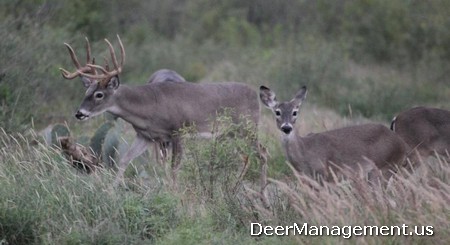Question: “I am wanting to get started more serious management of the whitetail deer found on the low fenced property that we hunt. I am thinking about starting to protein on our deer lease, which is about 9,000 acres in size. The ranch has a stable deer population, but we don’t believe we are overpopulated. The buck to doe ratio is close to even. Although most hunters will provide supplemental feed over an entire property, I’m thinking about just placing out two to three free choice feeders in the area.
I understand that there will be a lot of feed and money involved with food supplementation and it is not just a one year thing, but rather a long term investment. I understand it is a costly endeavor, but I don to do it as economically as possible. Is there any advice that you can offer?”
Deer Management: First off, you are correct. Providing high protein foods for the supplementation of whitetail deer diets is an expensive management practice. Do not simply drive to the feed store and start throwing 50 pound sacks of protein pellets into your truck. This is the most costly way to feed protein, especially since it sounds like you will be feeding a large amount, even with only 2 or 3 feeders going. There are however a couple of ways to cut costs.

The first would be to buy it bulk. This would mean that you purchase a trailer to tote the feed from the feed store yourself or you simply allow the dealer to enter your property and fill your feeders. If the feed store itself does not deliver then you may have to hire a middle-man to do the job. You will have to way potential investments versus your time and the amount of feed consumed by the deer to determine the most economical route.
Feeder Placement for Herd, Management, Hunting
It’s common for hunters to provide additional foods for deer, but it sounds like you are aiming for true diet supplementation for a portion of your ranch. With the addition of a couple to a few additional feeders on your 9,000 acre property I’m not sure that you get there completely, but the idea is way better than doing nothing because it will help deer on part of your deer lease. It’s tough to make a noticeable difference for each animal on your property if each animal does not get enough feed. You, of course, realize this since you do not plan to feed across the entire place.
My recommendation would be to place out at least 3 free-choice protein feeders is a triangle pattern near the core of your property. Use 16 or 20 percent protein but make sure to go with the 16 during the summer months. Try to position feeders about 1 mile, maybe a little further, apart. This would effectively cover about 2,000 to 2,500 acres since most deer will have home ranges than range from 400 to 700 acres during the non-breeding season. This feeder configuration would also ensure that deer receiving supplementation are more likely to remain on your property, i.e. your available feed becomes an important part of their home range.
Providing Protein and Low Fence Deer Management
Most hunters and land owners interested in deer management are looking to grow larger antlers on bucks. The feeder placement above will definitely do that since bucks tend to dominate protein-rich feeds. The larger bodied bucks will hit protein feeders hard, especially during times of low natural forage, i.e. summer. Forage is also invaluable to pregnant and nursing does, too. They will sneak in an get their share as well, even though the deer density is likely to rise on core of your property once feeders are installed.
This is actually why many landowners choose to fence a property. The fence does not just keep whitetail deer in, but also keeps deer out. It’s much more practical to feed when a property owner knows what to expect from year to year and can control buck harvest, buck to doe ratio and deer density. If these herd parameters are out of whack then the potential results of supplemental feeding of whitetail will be muted because of too many mouths to feed/not enough feed to function as a true supplement. If pellets are continually dumped into the system then feeding may also cause deer population and habitat problems because of too many animals.
Feeding of Deer: It’s Only a Supplement
It’s critically important to remember that feed is not a replacement for deer habitat! It is much better to manage deer forage by supplementing native habitat than to simply have deer survive on feed. After all, if they need it to survive it’s not a supplement to their diet, it IS their diet. Native plants will reach protein levels (30-35%) that pellets can not achieve at certain times of the year, but you have to have the habitat on the property if you want deer to have access to free and very high protein levels as part of their diet.
Supplemental feeding works best as part of a whitetail deer management operation when it’s deer are kept at the property carrying capacity for the habitat, buck and doe numbers are nearly equal and surveys/population estimates that are conducted annually to determine harvest objectives. Do all of the aforementioned things and your whitetail deer will remain healthy and it will save you both time as well as money. If you like the results then you may consider carrying fewer deer (increased reproduction because of increased health) and the installation of additional protein feeders in the future.